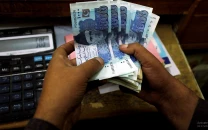Poverty to engulf 15m post floods
World Bank’s reveals GDP to fall around 1.4% to 2.4% in FY23

A preliminary assessment from the World Bank (WB) reveals that up to 15.4 million more Pakistanis will fall into poverty and the primary budget deficit could widen to 2.8% of the nation’s economy as a result of the flood.
The assessment reveals that the country’s economy will still grow in the range of 1.4% to 2.4% in the current fiscal year. But sticking to the International Monetary Fund (IMF) programme could jam the economic wheel. The Washington-based lender has shared its preliminary assessment of the economic and poverty impacts of the flood with the Ministry of Planning and Development and the Ministry for Economic Affairs, according to the sources in these ministries.
Although the initial assessment does not give any figure of total losses and damages, the estimated impact on economy and poverty does not suggest as high losses as $40 billion, claimed earlier by the government of Pakistan.
The WB prepared the assessment with the support of the Asian Development Bank (ADB), the United Nations and the European Union. A detailed report carrying the losses will follow soon.
According to the assessment, the flood will have a profound impact on lives and livelihoods. The WB indicated that the national poverty rate could further increase in the range of 4.5% to 7%, which will envelop another 9.9 million and 15.4 million people.
The poverty impact number is higher than the 9 million to 12 million, being worked out by the Ministry of Finance early this week. The report attributed the loss of household income, livestock, loss of assets, shortages of food and loss of human capital to 15.4 million people slipping into poverty, while those already below poverty line would face extreme consequences.
The WB stated that the floods were also expected to have a substantial negative impact on the economy. Livelihoods would be severely impacted, with poverty expected to increase significantly.
The WB suggested that the aggregated economic impact of floods would depend on the policy response. Substantial expenditures on relief, recovery, and rehabilitation could mitigate the losses in economic output at the potential cost of worsening fiscal and external imbalances. “In case the government gives preference to human needs over fiscal numbers, the overall real GDP growth is expected to slow from 6% of the previous fiscal year to a range of 1.4% to 2.4% in the current fiscal year,” showed the assessment.
The economic output impact was not very large, as before the floods the WB and the IMF had projected a 3.5% economic growth rate. The WB’s assessment of GDP growth was better than that of the Finance Ministry, which projected a growth rate of 1.2% to 1.7%.
However, the report projected the agriculture sector would contract for the first time in more than two decades. The growth of real agriculture sector output was projected to slow from 4.4% of the previous fiscal year to a range of negative 1% to negative 2.6% in the current fiscal year. The report suggested that GDP growth loss will be steeper, if the government tried to stick to the fiscal targets agreed with the IMF.
“Reductions in the government’s spending would exacerbate the decline in activity, leading the GDP growth to fall to around zero percent in FY23,” the report read.
Besides, tax collection would also fall behind target due to “strict adherence to deficit targets stipulated in the FY23”. The adherence to IMF targets would lead government consumption to contract by around 20%. Referring to fiscal impact, the report stated that in case the government cares about people, the primary budget deficit would be around 2.8% of the GDP. The lender underlined that the 2.8% of the GDP primary deficit –the gap between government revenues and expenditures after excluding the debt servicing – “would jeopardise the government’s budget target”.
Pakistan and the IMF had agreed on a primary budget surplus of 0.2% of the GDP, indicating that the total minimum impact of the floods on the budget is 3% of the GDP or Rs2.3 trillion.
The report mentioned that additional budget allocations were expected to meet relief and recovery needs over FY23 amid declines in revenue collections.
The WB said that the floods will also exacerbate external pressures. Around 50% of the required cotton input for the local textile industry is sourced domestically. With reduced supplies of domestic cotton, raw cotton imports were expected to increase to mitigate the shortage. At the same time, imports of food products, wheat, pulses, construction machinery, and medicines would also increase, based on increased needs and domestic shortages.
Meanwhile, reduced exports of textiles, rice, fruits and vegetables, leather products, cement, and sugar were expected to further widen the trade deficit.
Besides, there could be inflationary pressures that could further push food prices, according to the WB. With the hike in government administered energy prices, headline inflation had soared to 27.3% in August 2022, which the WB projected, is expected to increase further as food prices will rise following loss of livestock and damages to crop and transport infrastructure, critical for supplying agriculture output to markets.
The WB said that the macroeconomic risks facing Pakistan had been exacerbated by the floods. The government was facing a difficult policy challenge in supporting relief and recovery while maintaining progress towards macroeconomic stabilisation.
Published in The Express Tribune, September 17th, 2022.
Like Business on Facebook, follow @TribuneBiz on Twitter to stay informed and join in the conversation.



1728020501-0/Express-Tribune-Web-(13)1728020501-0-208x130.webp)







1726134115-0/BeFunk_-(41)1726134115-0-208x130.webp)







COMMENTS
Comments are moderated and generally will be posted if they are on-topic and not abusive.
For more information, please see our Comments FAQ